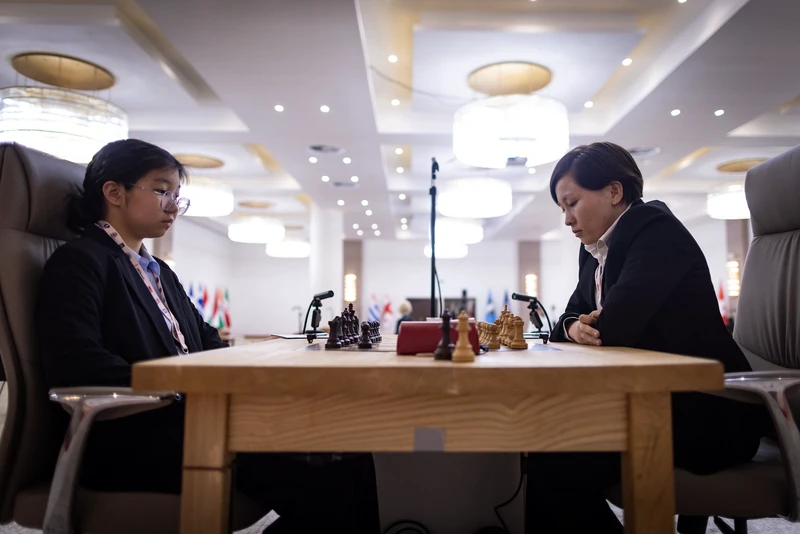Tournament Information
OnTheQueenside, who covers women’s chess, has published a detailed overview of the 2025 Women’s World Cup, including background information on the event and its players and predictions of who will win. Check it out here.
Bracket
The single elimination bracket with the pairings for each round can be found here.
Annotations by WGM Petra Papp
WGM Petra Papp has annotated the following games from round 3 of the 2025 Women’s World Cup:
https://lichess.org/study/PmL7NbB1/4K3fJWOZ#0
https://lichess.org/study/PmL7NbB1/PHmAawlO#0
Overview
Round 3 of the Women’s World Cup had to offer a bit of everything – a clash of rising talents, missed opportunities, most top seeds prevailing, but also the early elimination of an event’s favourite. Elnaz Kaliakhmet and Umida Omonova faced each other, with the former missing a critical opportunity in Game 1, and the latter eventually emerging as winner of the match. Nana Dzagnidze eliminates her opponent, Valentina Gunina in the tiebreaks, in an intense match where all 6 games were decisive. Tan Zhongyi, Lei Tingjie, Mariya Muzychuk and Zhu Jiner were all able to win their matches in the classical games. Song Yuxin was able to make one of the biggest upsets of the round, eliminating one of the favourites of the event, Anna Muzychuk, in the second tiebreak. Kateryna Lagno, despite her shaky start in the match, was able to eliminate Agrawal Vantika in the tiebreaks and advance to Round 4. With 16 players remaining in the event, Round 4 is expected to entertain us with some very close matchups, while Umida Omonova, the event’s underdog will face the event’s top seed, Lei Tingjie, for a spot in the quarter-finals
A clash of rising talents
Elnaz Kaliakhmet and Umida Omonova are no strangers to us in this edition of the Women’s World Cup, with both of them knocking out some of the rating favourites. Their clash for Round 3 could be nothing less than a thrilling, double-edged match. In Game 1, everything appeared to be in Kaliakhmet’s favour; navigating a position arising from the Semi-Tarrasch, White got an extra pawn. This isolated pawn on d5 is generally weak and Black can later re-gain it – exchanging material is usually a good plan, however it needs to be done cautiously without helping White improve her position. Omonova, however, spent too many moves on exchanges that improved her opponent’s position. The resulting pawn structure, with well protected c-d hanging pawns, gave her a healthy advantage. After the queens are exchanged, White seems to have made progress and enjoys a significant advantage, however the position still needed to be converted into the full point.
https://lichess.org/study/lFFlGQJk/tWuPxLs9#60
WFM Elnaz Kaliakhmet and WIM Umida Omonova
Photo: Anna Shtourman / FIDE
White now had two main options. The computer’s favourite, which is to go Re1 – Re7, and exploit the pinned knight, get some extra kingside pawns or win the knight, or another, interesting idea which could practically be even harder to deal with for Black. This idea would be 31. Rxd7!! giving up the exchange, however the two connected passed pawns are very strong, the rook on f6 highly misplaced, and the c7 rook passive, leaving Black with no good ways to prevent the pawns from promoting without losing significant material. In the actual game, Re1 was played, however she was not able to find the right followup. Omonova managed to exchange the strong c-d pawns for her own a-pawn, gaining White’s extra pawn back, and entering an equal endgame which would soon end in a draw.
This missed opportunity proved critical for the match, as in Game 2, it was Omonova who managed to get the upper hand in the game. With the Ruy Lopez played, Omonova managed to get an advantageous position and an extra pawn in the middlegame.
https://lichess.org/study/cFQCKKYB/1XOhCcaN#72
With the position being already hard to handle, a strange-looking 36…Bb1 by Black under time – and positional – pressure allowed White to further build on her advantage, and go on to win the game, eliminating Kaliakhmet 1.5-0.5.
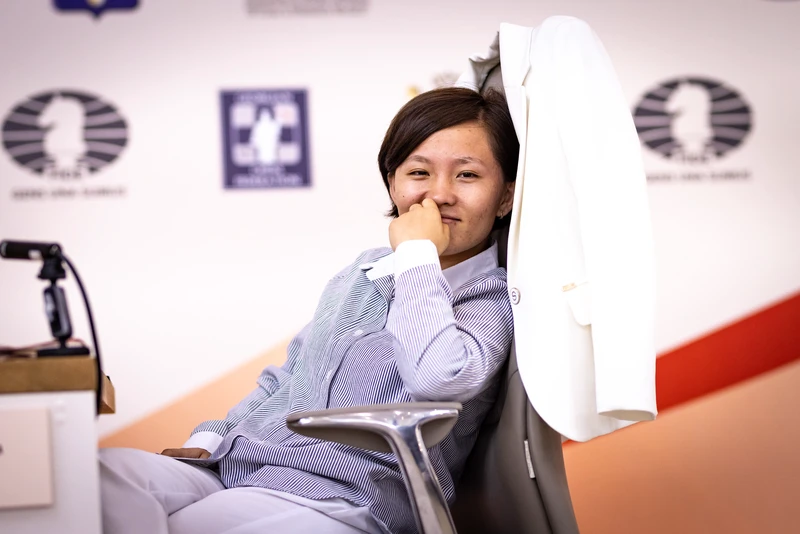
WIM Umida Omonova
Photo: Anna Shtourman / FIDE
The upset of the match
Anna Muzychuk, a veteran in elite events, was definitely one of the favourites of this event. Song Yuxin, however, proved herself more than capable of evenly battling her. With an early Game 1 draw, and a less early, but equally peaceful, Game 2 draw in the classical games, the match was to be decided in the tiebreaks. In Game 1 of the first tiebreaks, a questionable opening plan with 9…Bxb1 10…Qxd7, followed by a series of inaccurate choices, gave Muzychuk an overwhelming positional advantage.
https://lichess.org/study/nDcPtXdR/wK2mU4qf#28
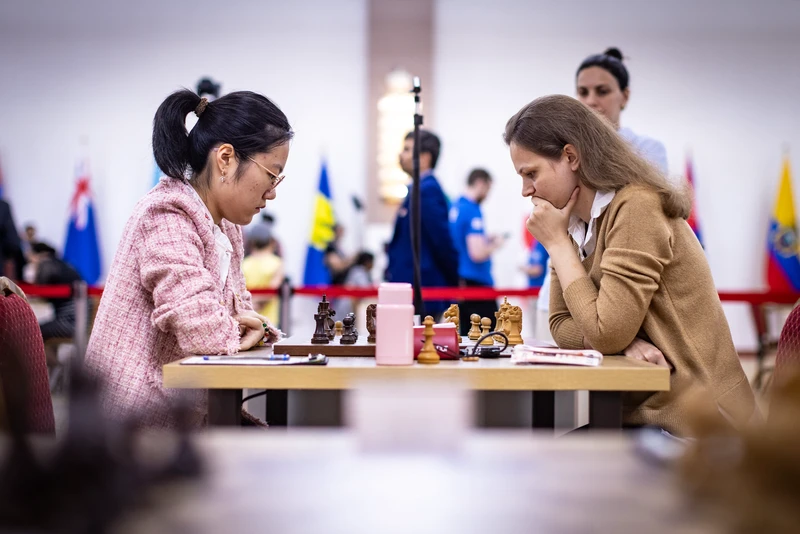
IM Song Yuxin and GM Anna Muzychuk
Photo: Anna Shtourman / FIDE
In fact, even though the queens have been exchanged, the black king is particularly vulnerable and Black had no pieces that could timely join the defence. Black was forced to resign by move 22, as she could no longer prevent the mate. One would assume that it would be very hard for Song Yuxin to recover, however the match was far from over for her! The rematch, until its very end, would not reveal to the slightest what was about to follow, as, with a draw being enough for her, Muzychuk managed to maintain the equality almost until the very end of the game. Yuxin, however, tried to maintain as active play as possible, and with her eventually managing to get both her rooks on the 7th rank, and with both players in time trouble, Muzychuk would need to be particularly careful
https://lichess.org/study/6VCtRlRH/H4ZfgBFn#87
Chasing White’s king was already not the right plan and would make Muzychuk’s position difficult to hold, however, under time pressure, Black overlooked a mate in 2 threat, sending the match to the second tiebreak, where it was Yuxin’s turn to lead the match.
https://lichess.org/study/TmqL7IZf/S8qC2Dg6#37
Muzychuk’s 19.Qxa7, capturing a seemingly free pawn, allowed her opponent significant initiative, which she was able to hold on and win Game 1 of the tiebreaks, putting her on the ropes. Song Yuxin was able to maintain the control of Game 2, eliminating Muzychuk and qualifying for Round 4 to face the Georgian IM Lela Javakhishvili.
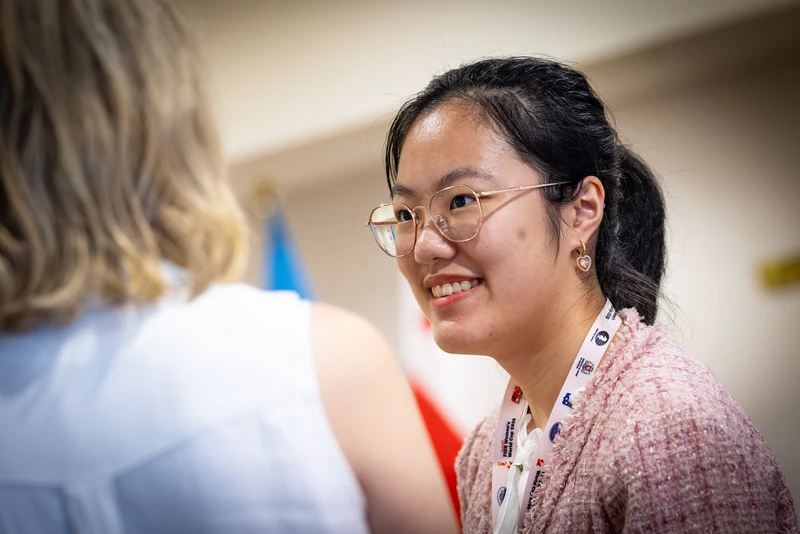
IM Song Yuxin
Photo: Anna Shtourman / FIDE
A favourite striking back
Kateryna Lagno found herself in a tough spot, in her match for Round 3 against Agrawal Vantika. A sub-optimal and probably rushed queenside attack plan by Lagno allowed her opponent to gain a superior position – ready to exploit the h1-a8 diagonal and the piece miscoordination to convert this positional advantage into a material one as well
https://lichess.org/study/lFFlGQJk/PCA6J6D9#40
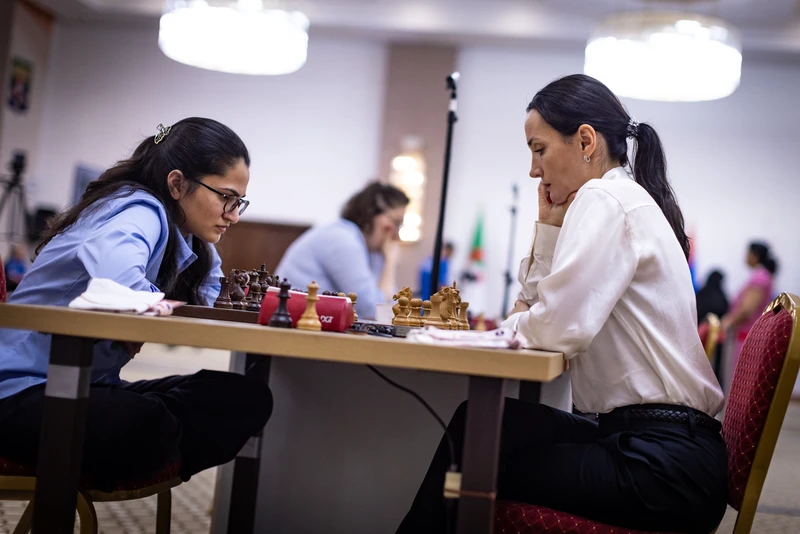
IM Agrawal Vantika and GM Kateryna Lagno
Photo: Anna Shtourman / FIDE
With e5 played, Vantika managed to win a piece for a pawn at the end of the line, and was able to convert this advantage into a win, getting Lagno into a must-win situation for Game 2.
In Game 2, Lagno appeared to be better prepared in the opening and more confident in the resulting middlegame, while Vantika got into time trouble already by move 20. White showed a better understanding of the position’s needs and was able to build an advantage, leaving Black with difficult decisions to make.
https://lichess.org/study/cFQCKKYB/yjmQODQm#53
Lagno is ready to deliver the final blow – any move except for the (difficult to find in a game under time pressure) Qc7 allows Lagno to exchange the rooks on e6 and create an unstoppable passed pawn. With Qa5 played this indeed happened, allowing Lagno to equalize the match, sending it to the rapid tiebreaks.
Neither player managed to achieve a significant advantage in Tiebreak 1, as well as Game 1 of Tiebreak 2, with all corresponding games ending in a draw – the match was to be decided in Game 2, by a kingside attack launched by Lagno, which Vantika did not manage to handle.
https://lichess.org/study/qmRKyUcO/fdmBqzn0#57
White has a very clear plan while Black would need to find only moves should she find 29…Rh8 – slowly waiting would not be enough. 29…h4 however allowed Lagno to speed up her attack, and eventually mate her opponent, winning the tiebreaks and qualifying for Round 4.
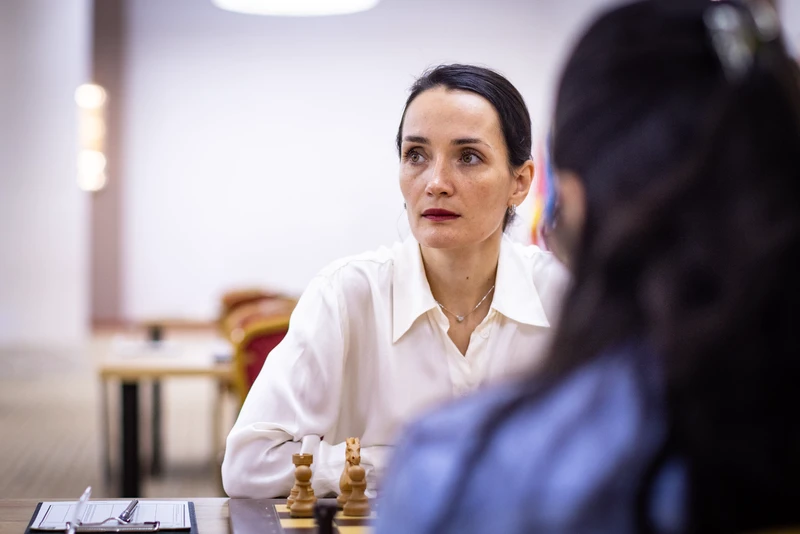
GM Kateryna Lagno
Photo: Anna Shtourman / FIDE
Puzzle Pack
Enjoy our collection of puzzles from the FIDE Women’s World Cup 2025!
https://lichess.org/study/6lb13AlX
